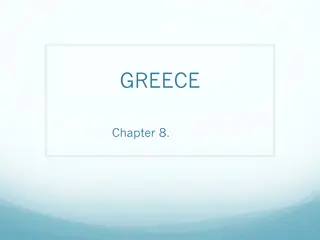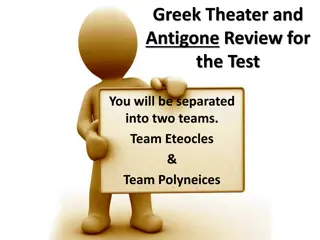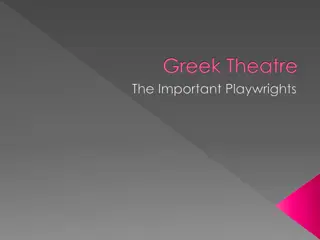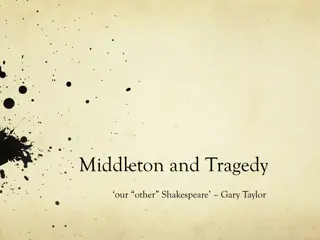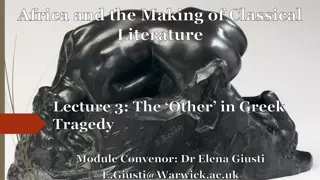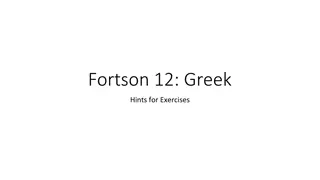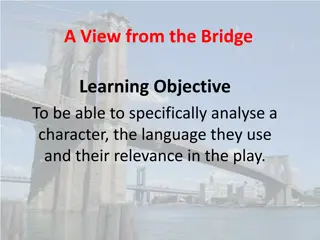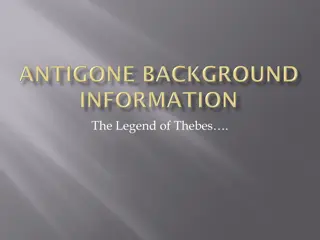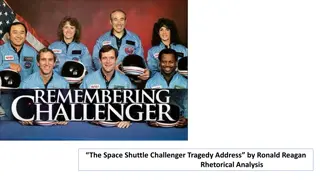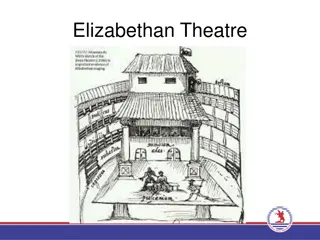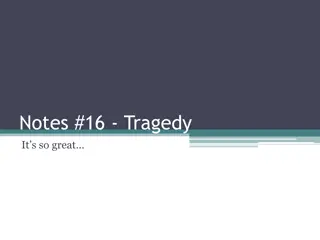Understanding the Elements of Greek Tragedy
Delve into the key components of Greek tragedy, exploring the characteristics of a tragic hero, the concept of tragic flaw (Hamartia), classic moments in the tragic plot, Aristotle's definition of tragedy, and the dramatic unities in a play. Discover the structure of a tragedy, from the prologue to the exodus, and the integral role of the chorus. Unveil the essence of this theatrical genre with insights into timeless works like Antigone.
Download Presentation

Please find below an Image/Link to download the presentation.
The content on the website is provided AS IS for your information and personal use only. It may not be sold, licensed, or shared on other websites without obtaining consent from the author. Download presentation by click this link. If you encounter any issues during the download, it is possible that the publisher has removed the file from their server.
E N D
Presentation Transcript
Antigone A Greek Tragedy
Tragic Hero Characteristics of a tragic hero: Undergoes a morally significant struggle that ends disastrously. Essentially a superior person who is treated sympathetically (we like them in spite of what the hero might do) Not all good or all bad (very human) Has a high, respected position to disgrace or unhappiness or death.
Tragic flaw (Hamartia) Hamartia some defect in the tragic character that helps cause his own ruin. For the Greeks this flaw is hubris (excessive pride). The flaw may seem to be jealousy, anger, ambition, etc., but it will always be because the character thinks himself too superior in some way. Because of this hubris, whatever happens to the tragic hero is not all undeserved.
Classic Moments in the tragic plot: Reversal of situation (peripety) good begins to slide or go bad Recognition (a.k.a. epiphany) discovery of the critical fact the hero realizes his own flaw has brought him to this low point. Scene of suffering destructive or painful action such as a death on the stage, bodily agony, wounds, etc. (the suffering and final submission of the hero) 1. 2. 3.
Aristotles definition of Tragedy Aristotle defines tragedy as the imitation of an action which is serious, complete, of a certain magnitude, couched in poetic language. It should be dramatic, with incidents arousing pity and fear, which bring about a purgation of these emotions. Pity is aroused in the audience for the character(s), and we fear lest the same misfortune happen to us. Purgation/catharsis is a cleansing; a release of emotions. According to Aristotle, comedy portrays men as worse than they are and tragedy as better than in actual life. He also notes that Sophocles drew men as they ought to be.
Dramatic Unities Time 24 hours for the action of the play. Place no change of scenery Action no subplot (an action which happens elsewhere is told by another character)
Structure of Tragedy Prologue introductory section that gives the background (usually expository rather than dramatic) Parados entrance of chorus; chorus chants more background to the story. Episodes and Stasimon Action begins with the first episode (usually 5 episodes) followed by a parados (chorus). The choral odes are called stasima. Exodus the final action of the play. 2 features: messenger speech and the deus ex machina, in which the deity is brought in to intervene in the action. Chorus there is always a chorus in Greek tragedy. Chorus fulfills several functions: Members sang, danced and played instruments Ideal audience responding to the action as the poet intended. Modulated the atmosphere and tone (representative of typical Athenian citizens conservative but not submissive) 4. Questions new characters as to origin or purpose 5. Choral odes showed the passage of time. 1. 2. 3. 4. 5. 1. 2. 3.
Antigoneby Sophocles Major conflict: Individual conscience at odds with established authority. Questions for discussion: When we know that those in power are morally wrong, do we break their laws, or do we collaborate with them by obeying? How important is doing the right thing? [What is right and what is wrong ?]
Kohlberg's Theory of Moral Development
Level I. PreconventionalMorality Stage 1. Obedience and Punishment People at this stage: Do not yet speak as members of society; they see morality as something external to themselves, as that which the big people say they must do See morality as a fixed set of rules Fear punishment from authority figures
Level I. PreconventionalMorality Stage 2Individualism and Exchange People at this stage: believe in more than one right view handed down by authorities understand that different people have different viewpoints view punishment as a risk that one wants to avoid Sees and values personal rewards for good behavior and this causes one to have some sense of right action
Level II. Conventional Morality Stage 3. Good Interpersonal Relationships People at this stage: believe that people should live up to the expectations of the family and community and behave in a good manner. think that good behavior = having good motives and interpersonal feelings such as love, empathy, trust and concern for others. exhibit a shift from unquestioning obedience to a relativistic outlook and a concern for motives. good
Level II. Conventional Morality Stage 4. Maintaining the Social Order People at this stage: are more broadly concerned with society as a whole (rather than simply the individual) emphasize obeying laws, respecting authority, and performing one s duty so that social order is maintained. believe that following laws (no matter what) is important, as without laws there would be chaos.
Level III. Postconventional Morality Stage 5: Social Contract and Individual Rights People at this stage: ask the question, What makes for a good society? begin to think about society in a theoretical way, stepping back from their individual concerns and society and considering the rights and values a society ought to uphold. believe a good society is conceived as a social contract into which people freely enter to work toward the benefit of all. believe basic rights, such as liberty and life should be protected. believe we should use some democratic procedures for changing unfair laws, in order to improved society. Agree to uphold laws until we can change them.
Level III. Postconventional Morality Stage 6: Universal Principles People at this stage: seek to define the principles by which we achieve justice follow the philosophies of great moral leaders such as Ghandi and Martin Luther King; treat the claims of all parties in an impartial manner, respecting the basic dignity of all people. look at moral dilemmas through another s eyes practice civil disobedience; believe that individuals have the right and responsibility to change injustice.
Kohlberg Theory in Practice Heinz Dilemma Monkey Experiment








